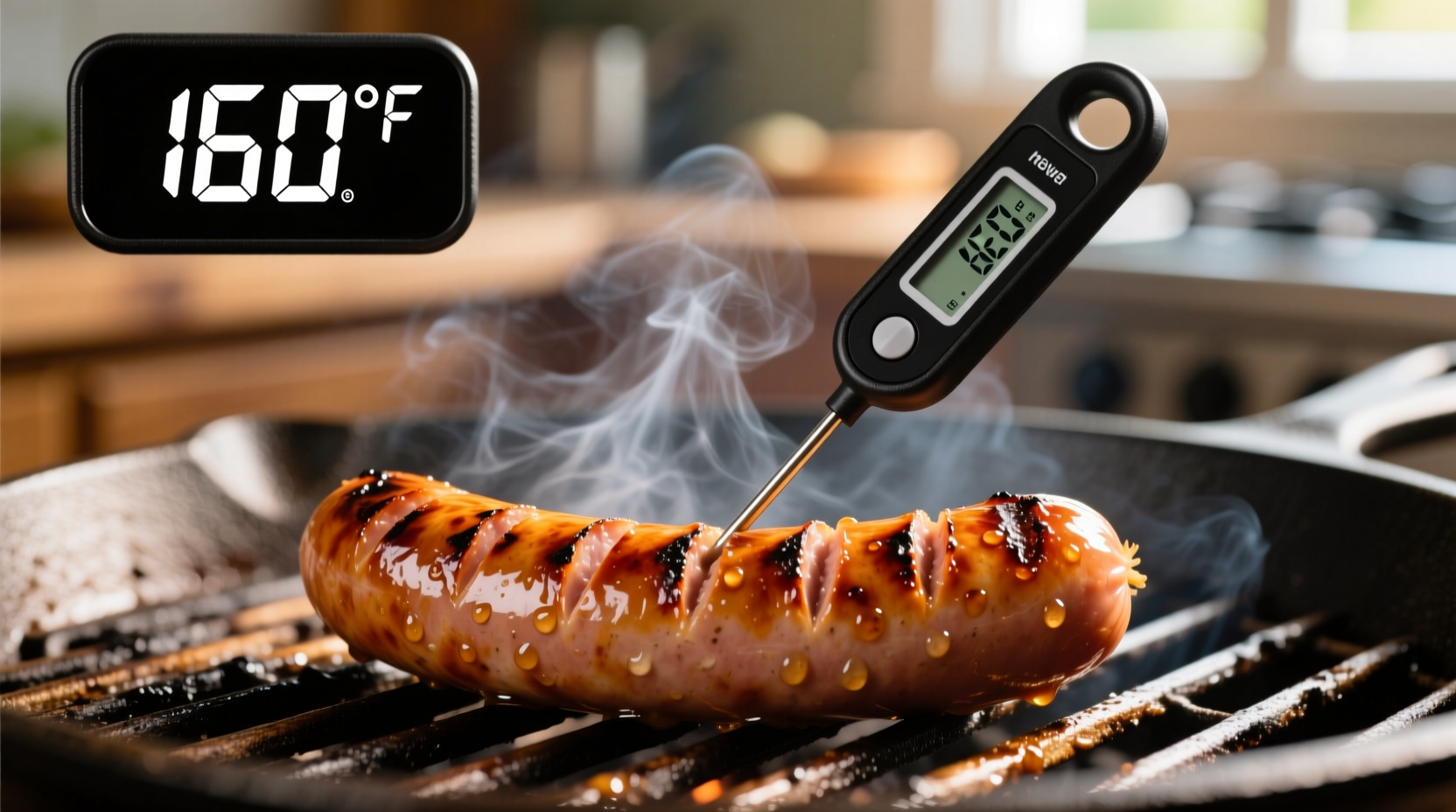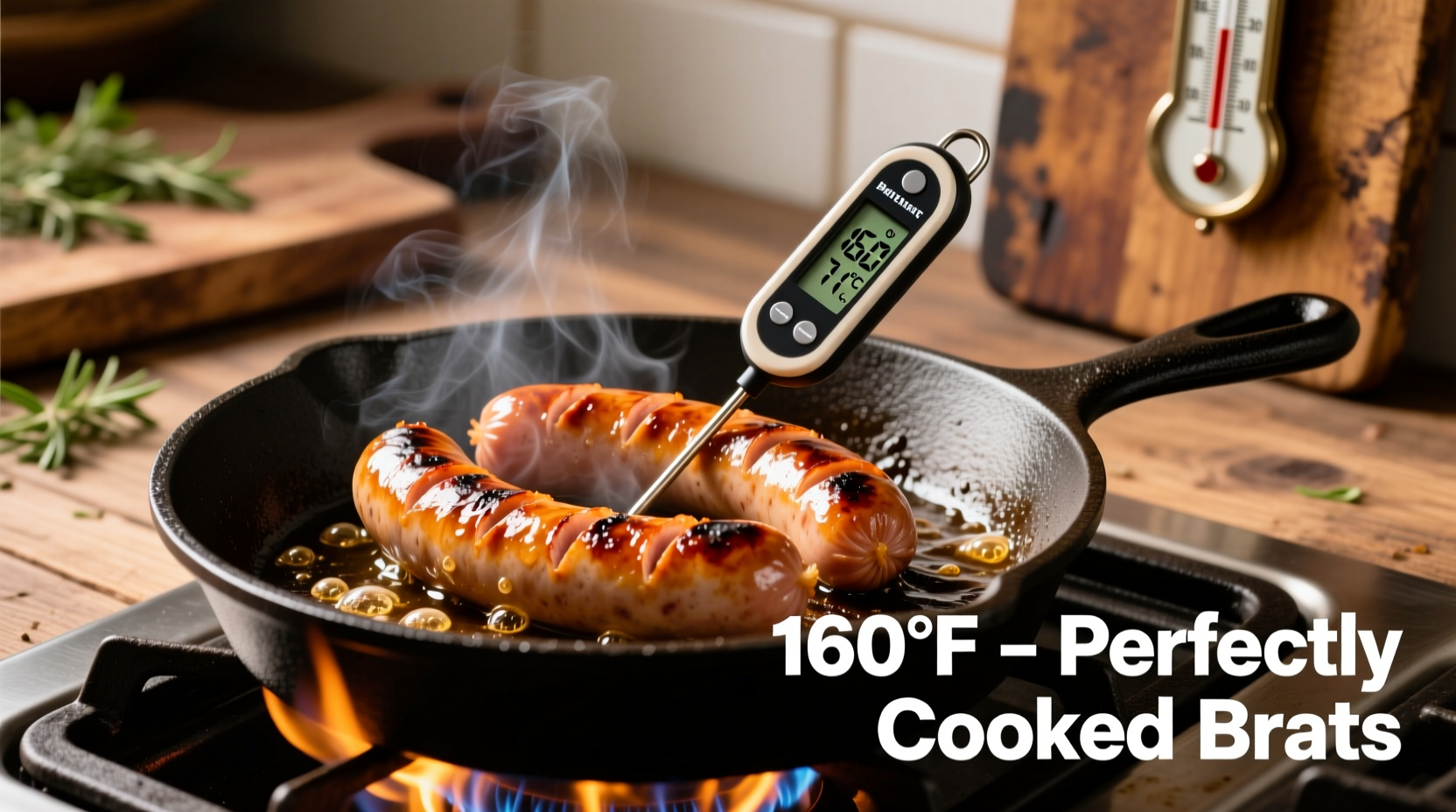Nothing ruins a backyard barbecue faster than serving undercooked brats or dry, overcooked sausages. Getting the temperature right isn't just about taste—it's critical for food safety. Whether you're grilling for game day or hosting a summer cookout, knowing exactly what temperature to cook brats to transforms your results from questionable to perfect every time.
Why Temperature Matters for Bratwurst Safety
Bratwurst, typically made from pork, requires proper cooking to eliminate harmful bacteria like Salmonella and E. coli. The USDA Food Safety and Inspection Service mandates that pork products reach 160°F (71.1°C) internally to ensure safety. Unlike whole cuts of meat where surface bacteria are the primary concern, ground meats like bratwurst distribute potential pathogens throughout the product.
| Meat Type | Safe Minimum Internal Temperature | Source |
|---|---|---|
| Pork sausages (including bratwurst) | 160°F (71.1°C) | USDA Food Safety Guidelines |
| Poultry sausages | 165°F (73.9°C) | USDA Food Safety Guidelines |
| Pre-cooked sausages (heating only) | 140°F (60°C) | USDA Food Safety Guidelines |
How to Accurately Measure Brat Temperature
Guessing doneness leads to foodborne illness or dry sausages. Follow these steps for precision:
- Use a reliable instant-read thermometer – Digital thermometers provide the most accurate readings in 3-5 seconds
- Insert at the thickest part – Avoid touching the cooking surface or bone (if present)
- Check multiple brats – Temperature can vary across the cooking surface
- Wait 10 seconds – Ensures accurate stabilization of the reading
Many home cooks make the mistake of relying on color or texture alone. Bratwurst can appear browned and firm while still being under 160°F internally. The only reliable method is temperature verification.

Temperature Considerations by Cooking Method
Different cooking techniques require slight temperature adjustments to achieve perfect results:
Grilling Brats
Start with indirect heat (300-350°F) for 15-20 minutes until they reach 150°F, then finish over direct heat to achieve caramelization while reaching the target 160°F. This two-stage method prevents casing rupture while ensuring thorough cooking.
Pan-Frying Brats
Cook over medium heat (325°F surface temperature) for 12-15 minutes, turning frequently. Reduce heat if browning too quickly before reaching 160°F internally. Adding 1/4 cup of liquid (beer, broth, or water) creates steam to help cook evenly.
Boiling Before Finishing
Some traditional methods call for par-boiling. If using this technique, simmer in liquid at 180-200°F (not boiling) for 10-12 minutes until they reach 150°F, then finish on the grill or pan to reach 160°F and develop flavor.
Avoiding Common Temperature Mistakes
Even experienced grillers make these temperature-related errors:
- Piercing brats – Releases juices, causing flare-ups and uneven cooking. Let the casing contain the juices until serving.
- Overcrowding the cooking surface – Lowers temperature and creates steam, preventing proper browning.
- Skipping the rest period – Let brats rest 3-5 minutes after reaching 160°F. Temperature will rise 2-5°F during this time (carryover cooking).
- Using visual cues alone – Brats can appear done at 140°F but still be unsafe.
What If You Don't Have a Thermometer?
While a thermometer is essential for food safety, these secondary indicators can help in a pinch:
- Texture test – Properly cooked brats feel firm but slightly springy when pressed
- Juice color – Clear juices (not pink) indicate proper cooking
- Casing appearance – Golden brown with slight blistering, not burnt or split
However, these methods are unreliable compared to temperature measurement. The USDA strongly recommends using a food thermometer for all meat products.
Temperature Timeline for Perfect Brats
Understanding how brats progress through temperature stages helps prevent common mistakes:
- 120-130°F – Fat begins to melt, but brats remain raw
- 140°F – Casing tightens, risk of bursting increases
- 150°F – Approaching safe zone, but still requires additional cooking
- 160°F – Safe minimum temperature reached, juices fully cooked
- 170°F+ – Risk of dryness and toughness begins
Monitoring this progression helps you understand why pulling brats at 160°F yields optimal results—any lower risks foodborne illness, while higher temperatures compromise texture.
Special Considerations for Different Brat Types
Not all brats follow the same temperature rules:
- Chicken or turkey brats – Require 165°F (73.9°C) internal temperature
- Pre-cooked brats – Only need to reach 140°F for serving (check packaging)
- Smoked brats – Often fully cooked during smoking process; heating to 140°F is sufficient
Always check product labels for specific preparation instructions, as manufacturing processes vary between brands.
Final Temperature Tips for Brat Perfection
Master these temperature-related techniques for consistently excellent results:
- Remove brats from heat at 155°F–they'll continue cooking to 160°F during resting
- Use a thermometer with a thin probe to avoid damaging casings
- Calibrate your thermometer regularly using ice water (32°F) or boiling water (212°F)
- When grilling, keep a spray bottle of water handy to control flare-ups without lowering temperature
Perfectly cooked brats should register 160°F internally with a juicy, flavorful interior and beautifully caramelized exterior. This precise temperature ensures both safety and maximum eating pleasure—the ultimate goal for any cook preparing this beloved sausage.











 浙公网安备
33010002000092号
浙公网安备
33010002000092号 浙B2-20120091-4
浙B2-20120091-4